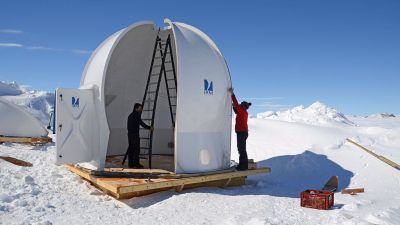
Christmas cheer, and a lot of hard work
The BELARE team celebrates Christmas in Antarctica as construction of a new geomagnetic observatory continues and a team heads to the Romnoes Nunatak to repair a radio relay.
A very Antarctic Christmas
The team at the Princess Elisabeth Antarctica station celebrated Christmas as they always do, with a plenty of good food and cheer. With an excellent dinner and our plastic Christmas tree adding a bit of ambiance, we had a festive evening.
The two cooks, David Rigotti and Riet Van de Velde, teamed up to prepare an excellent Christmas dinner. We were spoiled with tuna carpaccio as a starter, turkey as a main dish, fresh vegetables that had been flown in on the last flight into the station, and a delicious cake for dessert. It was so good we didn’t want to waste any of it. We’re still going through the leftovers several days later!
After dinner, everyone sat around and told stories of their experiences over the years, in Antarctica, the Arctic, or other interesting and remote parts of the globe they’d travelled to. Many of us also spent time Skyping with family and loved ones back home, as one tends to do on Christmas. With Belgians, Germans, a Brit, a Swiss, an Albanian and several Canadians taking part, it was a truly international evening.
We had been working too hard to have any energetic party. But at least being in Antarctica, we were able to have a white Christmas!
Geomagnetic observatory takes shape
The observatory the BELARE team is building for the GEOMAG project has been progressing nicely. The concrete support columns have been poured, the wooden support frame completed, and the fiberglass shell that will protect the instruments from the elements has been has been mounted. Everything will be ready for when Jean Rasson from the Royal Meteorological Institute of Belgium's Geophysical Center arrives to install all the instruments in a few weeks.
It’s certainly not easy to mix and pour concrete in subzero temperatures. You have to pre-heat the cement mix and sand, then pour the water into the cement mixer while it’s still warm. But this is the same team that managed to build an entire research station in much colder and windier conditions, so they've got the experience!
For gravel to mix into the cement, the builders added some loose rocks that were collected from a moraine next to a glacier not far form the station. It’s quite handy not to have to ship gravel in from elsewhere in the world if you’ve got a natural moraine with glacial debris nearby!
As everything in the observatory must be non-magnetic so as not to interfere with the instruments' readings, only fiberglass, aluminium, wood, and A4 grade stainless steel can be used in the observatory’s construction. The concrete pillars were reinforced with stainless steel bars when they were being poured. However, the builders had fixed the bars to each other using wire to keep them in place. Although the wires were stainless steel, there were last-minute doubts about them being non-magnetic A4 grade stainless steel, so it was decided to pull them out. Ilir Berisha had to put his arm into the wet cement all the way up to his shoulder to tear out the suspected wires. Everyone had huge smiles on their faces. It was a funny sight to see!
Repairing the radio relay
On Sunday, a party of electricians together with some strong guys from the Princess Elisabeth crew headed out to Romnoes Nunatak 60 km from the station on the way to the coast to repair the radio antenna relay. They made the four-hour drive on skidoos, hauling with them a lot of materials to make repairs. They took several 32 kg batteries to replace the ones that had likely frozen when the antenna stopped working.
The radio relay is very important for field communications in Antarctica. It allows teams in the field within a radius of 100 km to communicate with the station using a hand-held radio rather than a Iridium satellite phone, which can be very expensive.
When the team arrived at Romnoes Nunatak, they discovered that the antenna had snapped in two, and the solar panels powering it had blown away. The poles that had secured the solar panels to the rock had even been ripped up. And of course, the batteries, not in use, had frozen solid. All this damage was likely due to a very strong storm that happened over the austral winter. It must have been a true force of nature!
The team replaced the frozen batteries and erected a sturdy wind turbine to power the antenna, which they hope will be able to withstand the elements. They spent a good part of the day on the Romnoes Nunatak before making the four-hour trek back to the station, where we found them very tired and a lot more tan than when they left.
But the work for them isn’t over. They’ll have to return to Romnoes Nunatak to replace the entire antenna, which they weren’t expecting would be necessary when they first went.
There’s always work to be done in Antarctica!
Picture: The geomagnetic observatory is finally taking shape! - © Jos Van Hemelrijck / International Polar Foundation
